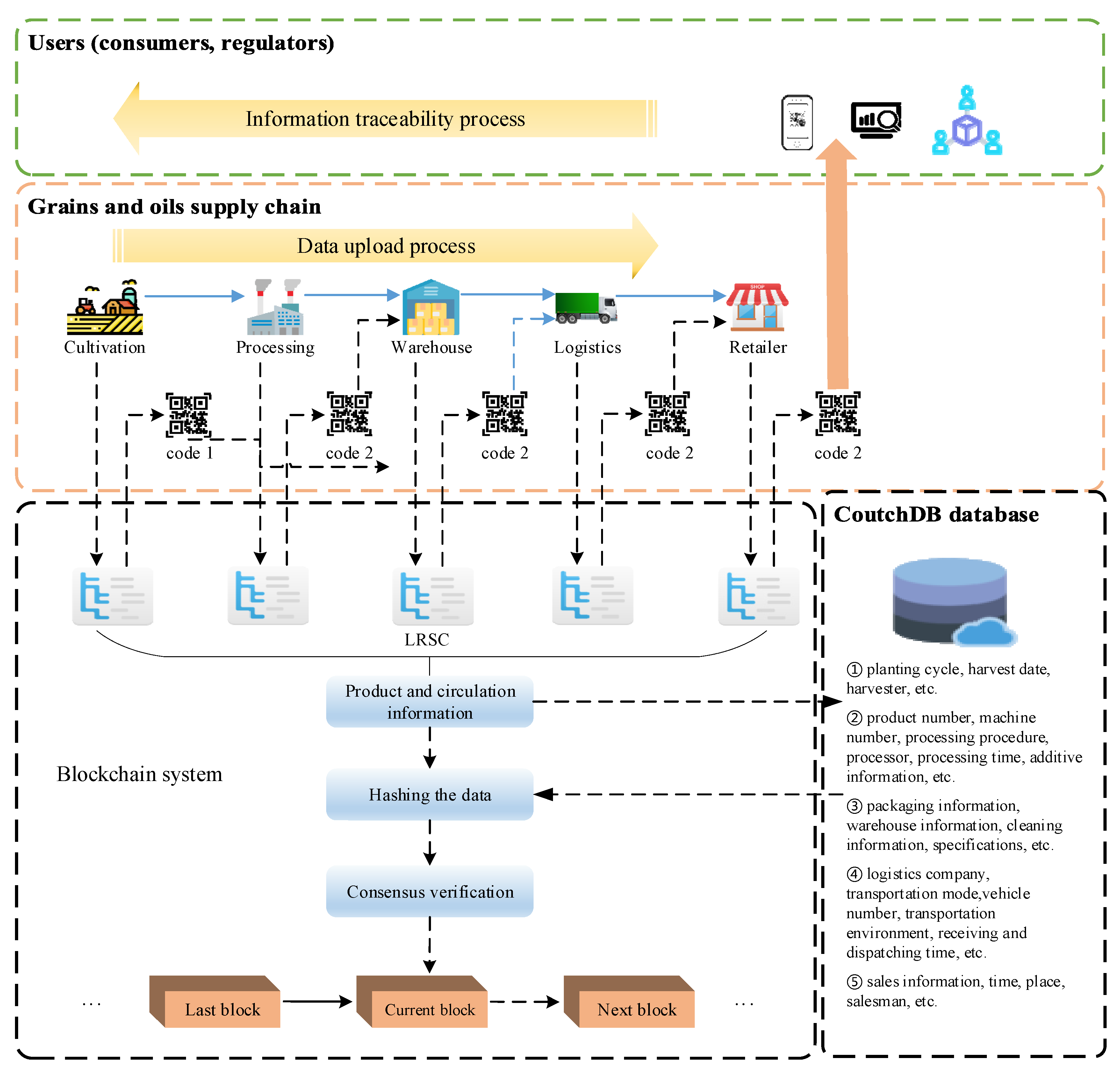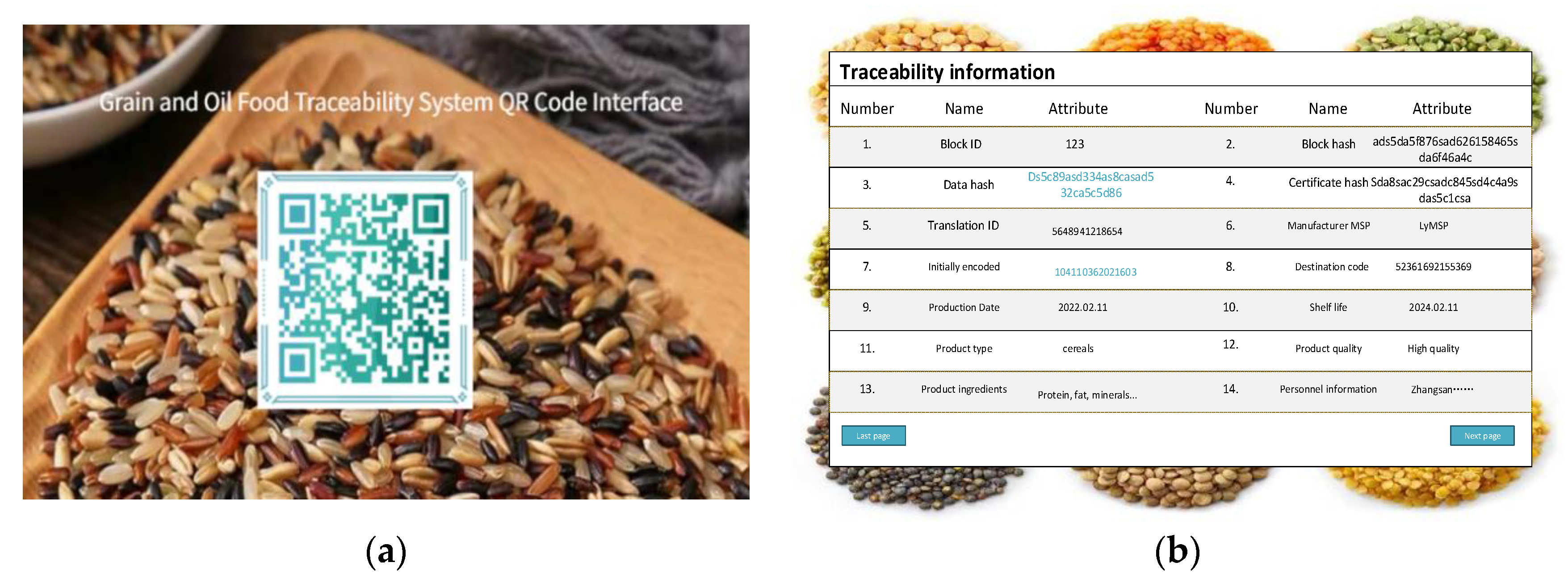Information Traceability Model for the Grain and Oil Food Supply Chain Based on Trusted Identification and Trusted Blockchain
Abstract
:1. Introduction
2. Research Methodology
2.1. Trusted Blockchain
2.2. Trusted Identification
2.3. Research Progress
3. Materials and Methods
3.1. Information Traceability Model of the Whole Supply Chain of Grain and Oil Food
3.1.1. Analysis the Supply Chain of Grain and Oil Food
3.1.2. Overall Framework of the Model
3.2. Model Mechanism Design
3.2.1. Trusted Identification Mechanism
3.2.2. Blockchain Master–Slave Multi-Chain Storage Mechanism
3.2.3. Trusted Traceability Mechanism
4. Results and Discussion
4.1. Model Running Process Analysis
4.2. Systematic Realization
4.3. System Operation Result Analysis
5. Conclusions and Future Outlook
Author Contributions
Funding
Institutional Review Board Statement
Informed Consent Statement
Data Availability Statement
Conflicts of Interest
Appendix A
| Algorithm A1. SDSC |
| Input: H(i); Data; D; Ds Authority()//Authorization Template { Verify(H(i))//Authenticate user unique hash } Standardization()//Data Standardization Module { Arrange(Data)//The data is matched and arranged to produce D } Summary()//Data table processing module { Hash(D)//Get D hash } Storage()//Storage module { Encryption(Ds)//digest encryption Chain(D,Ds)//D,Ds wind up } |
| Algorithm A2. VDSC |
| Input: RDS; D Obtain()//get data module { DRDS//Get CoutchDB’S D Hash(D)//Get D in the CoutchDB database } Judgment()//Judgment module { Decrypt(Ds)//Decrypt Ds Verify(Ds)//Verify Ds } Storage()//Storage module { Chain(R)//R real-time on-chain } |
| Algorithm A3. LRSC |
| Input: code; Dc; Dd; Obtain()//Get identification code information module { Get(code)Dc//Get Dc } Check()//Check module { Get(Ds)//Get Ds Verity(Dc)//Verify Dc } Renew()//Update identification code information module { Addition(Dd)//Add the data of this link and update the QR code information } Storage()//Memory module { Transfer(SDSC,VDSC)//Call SDSC,VDSC perform data upload } |
References
- Sluyter, C.; LeBlanc, K.; Hicks-Roof, K. Boosting Whole-Grain Utilization in the Consumer Market: A Case Study of the Oldways Whole Grains Council’s Stamped Product Database. Nutrients 2022, 14, 713. [Google Scholar] [CrossRef] [PubMed]
- Chung, S.; Hwang, J.-T.; Park, S.-H. Physiological Effects of Bioactive Compounds Derived from Whole Grains on Cardiovascular and Metabolic Diseases. Appl. Sci. 2022, 12, 658. [Google Scholar] [CrossRef]
- Cui, Y.; Hao, P.; Liu, B.; Meng, X. Effect of traditional Chinese cooking methods on fatty acid profiles of vegetable oils. Food Chem. 2017, 233, 77–84. [Google Scholar] [CrossRef] [PubMed]
- Elena, L.M.; Marta, M.; Mariangela, L.; Angelo, C. Voluntary traceability in food supply chain: A framework leading its implementation in Agriculture 4.0. Technol. Forecast. Soc. Chang. 2022, 178, 121564. [Google Scholar]
- Palocci, C.; Presser, K.; Kabza, A.; Pucci, E.; Zoani, C. A Search Engine Concept to Improve Food Traceability and Transparency: Preliminary Results. Foods 2022, 11, 989. [Google Scholar] [CrossRef]
- Wang, R.; Chen, X. Research on Agricultural Product Traceability Technology (Economic Value) Based on Information Supervision and Cloud Computing. Comput. Intell. Neurosci. 2022, 2022, 4687639. [Google Scholar] [CrossRef]
- Bux, C.; Varese, E.; Amicarelli, V.; Lombardi, M. Halal Food Sustainability between Certification and Blockchain: A Review. Sustainability 2022, 14, 2152. [Google Scholar] [CrossRef]
- Prashar, D.; Jha, N.; Jha, S.; Lee, Y.; Joshi, G.P. Blockchain-Based Traceability and Visibility for Agricultural Products: A Decentralized Way of Ensuring Food Safety in India. Sustainability 2020, 12, 3497. [Google Scholar] [CrossRef] [Green Version]
- Tarricone, L.; Grosinger, J. Augmented RFID Technologies for the Internet of Things and Beyond. Sensors 2020, 20, 987. [Google Scholar] [CrossRef] [Green Version]
- Li, X.; Russell, P.; Mladin, C.; Wang, C. Blockchain-Enabled Applications in Next-Generation Wireless Systems: Challenges and Opportunities. IEEE Wirel. Commun. 2021, 28, 86–95. [Google Scholar] [CrossRef]
- Anagnostakis, A.G.; Giannakeas, N.; Tsipouras, M.G.; Glavas, E.; Tzallas, A.T. IoT Micro-Blockchain Fundamentals. Sensors 2021, 21, 2784. [Google Scholar] [CrossRef] [PubMed]
- Nguyen, D.-H.; Tuong, N.H.; Pham, H.-A. Blockchain-based Farming Activities Tracker for Enhancing Trust in the Community Supported Agriculture Model. In Proceedings of the International Conference on Information and Communication Technology Convergence (ICTC), Jeju, Korea, 21–23 October 2020; pp. 737–740. [Google Scholar]
- LI, P.; Xu, H. Blockchain User Anonymity and Traceability Technology. J. Electron. Inf. Technol. 2020, 42, 1061–1067. [Google Scholar]
- Naresh, V.S.; Allavarpu, V.V.L.D.; Reddi, S. Provably secure blockchain privacy-preserving smart contract centric dynamic group key agreement for large WSN. J. Supercomput. 2022, 78, 8708–8732. [Google Scholar] [CrossRef]
- Perboli, G.; Musso, S.; Rosano, M. Blockchain in Logistics and Supply Chain: A Lean Approach for Designing Real-World Use Cases. IEEE Access 2018, 6, 62018–62028. [Google Scholar] [CrossRef]
- Zhou, Y.; Chen, L. Secure Storage and Deletion Based on Blockchain for Cloud Data with Fine-grained Access Control. J. Electron. Inf. Technol. 2021, 43, 1856–1863. [Google Scholar]
- Hou, B.; Hou, J.; Wu, L. Consumer Preferences for Traceable Food with Different Functions of Safety Information Attributes: Evidence from a Menu-Based Choice Experiment in China. Int. J. Environ. Res. Public Health 2020, 17, 146. [Google Scholar] [CrossRef] [Green Version]
- Choi, T.-M.; Siqin, T. Blockchain in logistics and production from Blockchain 1.0 to Blockchain 5.0: An intra-inter-organizational framework. Transp. Res. Part E 2022, 160, 102653. [Google Scholar] [CrossRef]
- Fu, Y.; Zhu, J. Operation Mechanisms for Intelligent Logistics System: A Blockchain Perspective. IEEE Access 2019, 7, 144202–144213. [Google Scholar] [CrossRef]
- Dasaklis, T.K.; Voutsinas, T.G.; Tsoulfas, G.T.; Casino, F. A Systematic Literature Review of Blockchain-Enabled Supply Chain Traceability Implementations. Sustainability 2022, 14, 2439. [Google Scholar] [CrossRef]
- Amy, T.; Jörg, W.; Claus, L. Object Identification Technologies as Key Enabler for Circular Business Models. Chem. Ing. Tech. 2022, 94, 479–492. [Google Scholar]
- Xie, Z.; Kong, H.; Wang, B. Dual-Chain Blockchain in Agricultural E-Commerce Information Traceability Considering the Viniar Algorithm. Sci. Program. 2022, 2022, 2604216. [Google Scholar] [CrossRef]
- Al-Hashedi, A.H.; Arshad, M.R.H.M.; Baharudin, A.S.; Mohamed, H.H.; Osman, O. Strategic information systems planning for RFID implementation in Hajj management systems. In Proceedings of the 6th International Conference on Information Technology and Multimedia, Putrajaya, Malaysia, 18–20 November 2014; pp. 146–150. [Google Scholar]
- Bernardis, C.; Cremonesi, P. NFC: A deep and hybrid item-based model for item cold-start recommendation. User Modeling User-Adapt. Interact. 2021, 1–34. [Google Scholar] [CrossRef]
- Lu, L. Research on Anti-Counterfeiting Technology Based on Encrypted Two-Dimensional Code. Insight-Information 2020, 2. [Google Scholar] [CrossRef]
- Anna, S.; Hasmik, B.; Tiago, P.; Paulo, L. Secure data exchange in Industrial Internet of Things. Neurocomputing 2022, 484, 183–195. [Google Scholar]
- Adamashvili, N.; State, R.; Tricase, C.; Fiore, M. Blockchain-Based Wine Supply Chain for the Industry Advancement. Sustainability 2021, 13, 13070. [Google Scholar] [CrossRef]
- Ryan, A.; Abdurrezzak, S.; John, R. A Simulation for Managing Retail Inventory Flow Using RFID and Bar Code Technology. Decis. Sci. J. Innov. Educ. 2021, 19, 214–223. [Google Scholar] [CrossRef]
- Marchi, G.; Mulloni, V.; Hammad Ali, O.; Lorenzelli, L.; Donelli, M. Improving the Sensitivity of Chipless RFID Sensors: The Case of a Low-Humidity Sensor. Electronics 2021, 10, 2861. [Google Scholar] [CrossRef]
- Salah, K.; Nizamuddin, N.; Jayaraman, R. Blockchain-based soybean traceability in agricultural supply chain. IEEE Access 2019, 7, 73295–73305. [Google Scholar] [CrossRef]
- Tao, Q.; Cui, X.; Huang, X. Food Safety Supervision System Based on Hierarchical Multi-Domain Blockchain Network. IEEE Access 2019, 7, 51817–51826. [Google Scholar] [CrossRef]
- Leite, N.; Santos, A.; Lopes, N. Assuring M2M Secure Transactions via Blockchain and Smart Contracts. J. Commun. Softw. Syst. 2021, 17, 260–269. [Google Scholar] [CrossRef]
- Lin, Q.; Wang, H.; Pei, X.; Wang, J. Food Safety Traceability System Based on Blockchain and EPCIS. IEEE Access 2019, 7, 20698–20707. [Google Scholar] [CrossRef]
- Varavallo, G.; Caragnano, G.; Bertone, F.; Vernetti-Prot, L.; Terzo, O. Traceability Platform Based on Green Blockchain: An Application Case Study in Dairy Supply Chain. Sustainability 2022, 14, 3321. [Google Scholar] [CrossRef]
- Wang, L.; He, Y.; Wu, Z. Design of a Blockchain-Enabled Traceability System Framework for Food Supply Chains. Foods 2022, 11, 744. [Google Scholar] [CrossRef] [PubMed]
- Caro, M.P.; Ali, M.S.; Vecchio, M.; Giaffreda, R. Blockchain-based traceability in Agri-Food supply chain management: A practical implementation. In Proceedings of the IoT Vertical and Topical Summit on Agriculture-Tuscany (IOT Tuscany), Tuscany, Italy, 8–9 May 2018; pp. 1–4. [Google Scholar]
- Tsang, Y.P.; Choy, K.L.; Wu, C.H.; Ho, G.T.S.; Lam, H.Y. Blockchain-Driven IoT for Food Traceability With an Integrated Consensus Mechanism. IEEE Access 2019, 7, 129000–129017. [Google Scholar] [CrossRef]
- Sun, L.; Sun, H.; Cao, N.; Han, X.; Cao, G.; Huo, W.; Zhu, D.; Higgs, R. Intelligent agriculture technology based on internet of things. Intell. Autom. Soft Comput. 2022, 32, 429–439. [Google Scholar] [CrossRef]
- Al-Rakhami, M.S.; Al-Mashari, M. ProChain: Provenance-Aware Traceability Framework for IoT-Based Supply Chain Systems. IEEE Access 2022, 10, 3631–3642. [Google Scholar] [CrossRef]
- Lei, Y.; Wanrong, Z.; Jianggan, W.; Zi, T. EdgeShare: A blockchain-based edge data-sharing framework for Industrial Internet of Things. Neurocomputing 2022, 485, 219–232. [Google Scholar]
- Duque-Acevedo, M.; Belmonte-Ureña, L.J.; Yakovleva, N.; Camacho-Ferre, F. Analysis of the Circular Economic Production Models and Their Approach in Agriculture and Agricultural Waste Biomass Management. Int. J. Environ. Res. Public Health 2020, 17, 9549. [Google Scholar] [CrossRef]
- Meng, X.; Liu, M.; Wang, M.; Wang, J.; Wu, Q. Fuzzy min-max neural network with fuzzy lattice inclusion measure for agricultural circular economy region division in Heilongjiang Province in China. IEEE Access 2020, 8, 36120–36130. [Google Scholar] [CrossRef]
- Rodias, E.; Aivazidou, E.; Achillas, C.; Aidonis, D.; Bochtis, D. Water-Energy-Nutrients Synergies in the Agrifood Sector: A Circular Economy Framework. Energies 2021, 14, 159. [Google Scholar]
- Yakubu, B.M.; Latif, R.; Yakubu, A.; Khan, M.I.; Magashi, A.I. RiceChain: Secure and traceable rice supply chain framework using blockchain technology. PeerJ Comput. Sci. 2022, 8, e801. [Google Scholar] [CrossRef] [PubMed]
- Bhat, S.A.; Huang, N.-F.; Sofi, I.B.; Sultan, M. Agriculture-Food Supply Chain Management Based on Blockchain and IoT: A Narrative on Enterprise Blockchain Interoperability. Agriculture 2022, 12, 40. [Google Scholar] [CrossRef]
- Iftekhar, A.; Cui, X.; Tao, Q.; Zheng, C. Hyperledger Fabric Access Control System for Internet of Things Layer in Blockchain-Based Applications. Entropy 2021, 23, 1054. [Google Scholar] [CrossRef] [PubMed]













| Category | Research Content | References |
|---|---|---|
| Blockchain-based food or crop traceability solution | Solve the problem of traceability of existing food or crops through blockchain technology | [13,20,22,30,31,32,33,34] |
| Research on traceability of food or crops based on identification technology | Make the data information of the traceability system credible through identification technology | [23,28,29,35] |
| Building a traceability solution based on the Internet of Things | Collect and identify information data through IoT devices | [11,36,37,38,39,40] |
| Agriculture and the Circular Economy | Point out the importance of agriculture for circular economy through research literature | [38,41,42,43] |
Publisher’s Note: MDPI stays neutral with regard to jurisdictional claims in published maps and institutional affiliations. |
© 2022 by the authors. Licensee MDPI, Basel, Switzerland. This article is an open access article distributed under the terms and conditions of the Creative Commons Attribution (CC BY) license (https://creativecommons.org/licenses/by/4.0/).
Share and Cite
Zhang, X.; Li, Y.; Peng, X.; Zhao, Z.; Han, J.; Xu, J. Information Traceability Model for the Grain and Oil Food Supply Chain Based on Trusted Identification and Trusted Blockchain. Int. J. Environ. Res. Public Health 2022, 19, 6594. https://doi.org/10.3390/ijerph19116594
Zhang X, Li Y, Peng X, Zhao Z, Han J, Xu J. Information Traceability Model for the Grain and Oil Food Supply Chain Based on Trusted Identification and Trusted Blockchain. International Journal of Environmental Research and Public Health. 2022; 19(11):6594. https://doi.org/10.3390/ijerph19116594
Chicago/Turabian StyleZhang, Xin, Yue Li, Xiangzhen Peng, Zhiyao Zhao, Jiaqi Han, and Jiping Xu. 2022. "Information Traceability Model for the Grain and Oil Food Supply Chain Based on Trusted Identification and Trusted Blockchain" International Journal of Environmental Research and Public Health 19, no. 11: 6594. https://doi.org/10.3390/ijerph19116594






